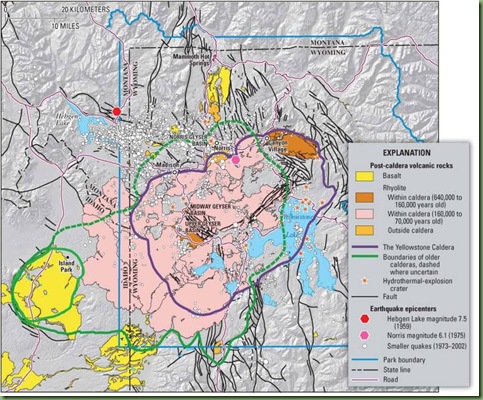Barely escaping hypothermia and an almost certain demise during my spur-of-the-moment venture into the frigid high country of Dunraven Pass and the Washburn Range last week, I soon forged onward in my endeavors. Actually, I did not so much forge onward as I simply forged back down the mountain. By this time the gray clouds had thinned to patchy blue sky but the temperature hovered around 38°F. I cruised down that twisting mountain road with a song in my heart – I was bound for Norris Geyser Basin, my original destination for the afternoon.


Norris is located outside the boundary of the latest 640,000–year–old Yellowstone caldera (the circular basin formed during the collapse of the volcanic crater) but inside the boundary of the oldest (and largest) caldera created around 2.1 million years ago.
 |
| Image courtesy of USGS |
The map image above describes the three main caldera boundaries, with Island Park, at around 1.3 million years old the second and smallest, found in eastern Idaho. It shows that the youngest (most recent) volcanic explosion overlapped a fair part of the oldest one and so would have obliterated much of the evidence for this oldest explosion except mainly in the southwestern part of the park and eastern Idaho.
Most of the other hydrothermal features we see today in the park are within the youngest Yellowstone caldera boundary. Many hot springs and fumaroles (steam vents) in Norris reach temperatures above the boiling point of 200°F. Since Norris is also one of the hottest, most acidic, and most dynamic of the park’s thermal areas, I have been curious about the connection between this distinction and its location.
As part of one of the world’s largest active volcanic systems, it also sits on the intersection of three major faults. Two faults intersect with a “ring fracture” formed during the 640,000–year–old caldera collapse. It is these conditions which helped to create this dynamic geyser basin.
 |
| Norris Geyser Basin |
Norris has the greatest water chemistry array among all of Yellowstone’s hydrothermal areas. As the water levels fluctuate in the underground hot water reservoirs beneath the geyser basin, concentrations of chloride, sulfate, iron, and arsenic also change. Norris’s thermal waters also contain the highest concentration of silica, which is the primary component of glass and many quartz beach sands.
I cannot help but wander around in sheer amazement at these geyser basins. The rainbow colors, bubbling mud, hissing steam, and overpowering odors of Porcelain Basin contrast starkly with Back Basin and its thermal features scattered and isolated amidst spindly and stunted lodgepole pines.
 |
| Porcelain Basin |
 |
| Back Basin |
Many of the colors seen in Norris Geyser Basin are evidence of heat-loving organisms called thermophiles.
Orange coloration is often a result of the presence of iron and arsenic in the thermal waters.
In general, yellow deposits contain sulfur; some of the thermophiles form communities in the hottest acidic thermal runoff at temperatures between 140°F and 181°F.
Dark brown, rust, or red colors in runoff channels contain varying amounts of iron. These thermophilic communities often form in water below 140°F.
Algae are the dominant life form in the emerald–green mats coloring many runoff channels, forming in temperatures below 135°F.
Dark blackish–green mats form in even cooler waters.



Colors within thermal waters change, too, because temperatures and chemistry change. In hot springs, the hottest water is nearest the vent coming from deep underground. As the water flows on the ground away from the vent, the water gradually cools. The chemical composition of the thermal runoff waters also changes as water flows from some particular feature, mixes with other water sources, and is either diluted or concentrated. As temperatures or chemical composition change, the heat-loving thermophiles gravitate to a more favorable location in the runoff channel.






